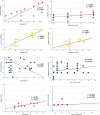Test, track, treat using wearable sensors for management of Parkinson's disease: 12‑month prospective observational United Arab Emirates study using Parkinson's Kinetograph (EmPark-PKG Study)
- PMID: 39730960
- PMCID: PMC11909079
- DOI: 10.1007/s00702-024-02873-0
Test, track, treat using wearable sensors for management of Parkinson's disease: 12‑month prospective observational United Arab Emirates study using Parkinson's Kinetograph (EmPark-PKG Study)
Abstract
Parkinson's disease (PD) is a progressive neurodegenerative disorder marked by both motor and non-motor symptoms that necessitate ongoing clinical evaluation and medication adjustments. Home-based wearable sensor monitoring offers a detailed and continuous record of patient symptoms, potentially enhancing disease management. The EmPark-PKG study aims to evaluate the effectiveness of the Parkinson's KinetoGraph (PKG), a wearable sensor device, in monitoring and tracking the progression of motor symptoms over 12 months in Emirati and non-Emirati PD patients. Fifty PD patients (32% Emirati, 68% non-Emirati) were assessed at baseline and a 12-month follow-up. Clinical evaluations included levodopa equivalent daily dosage (LEDD) and motor and non-motor assessments. Concurrently, the PKG provided metrics such as bradykinesia score (BKS) and dyskinesia score (DKS). Statistical analyses were conducted to determine changes from baseline to six months, differences between Emirati and non-Emirati groups, and correlations between PKG metrics and clinical assessments. Significant reductions in LEDD and improvements in both motor and non-motor scores were observed from baseline to six months (p < 0.05). PKG-guided medication adjustments were associated with enhanced motor and non-motor outcomes (p < 0.05). Specifically, non-Emirati patients exhibited a significant reduction in LEDD (Z = - 2.010, p = 0.044), whereas Emirati patients did not (Z = - 0.468, p = 0.640). Both groups showed significant improvements in motor scale scores and motor complication scores. Spearman correlation analysis revealed strong relationships between PKG metrics and subjective clinical assessments (p < 0.001). The EmPark-PKG study demonstrates the potential benefits of remote PKG monitoring for personalised motor symptom management in PD. PKG supports a stepped care paradigm by enabling bespoke medication titration based on objective data, facilitating tailored and effective patient care.
Keywords: Objective measurements; PKG; Parkinson’s disease; Remote monitoring; UAE.
© 2024. The Author(s).
Conflict of interest statement
Declarations. Conflict of interest: The authors declare that they have no known competing financial interests or personal relationships that could have appeared to influence the work reported in this paper.
Figures


Similar articles
-
Comparison of the Parkinson's KinetiGraph to off/on levodopa response testing: Single center experience.Clin Neurol Neurosurg. 2021 Oct;209:106890. doi: 10.1016/j.clineuro.2021.106890. Epub 2021 Aug 13. Clin Neurol Neurosurg. 2021. PMID: 34455169
-
A 12-month prospective real-life study of opicapone efficacy and tolerability in Emirati and non-White subjects with Parkinson's disease based in United Arab Emirates.J Neural Transm (Vienna). 2024 Jan;131(1):25-30. doi: 10.1007/s00702-023-02700-y. Epub 2023 Oct 5. J Neural Transm (Vienna). 2024. PMID: 37798410 Free PMC article.
-
Objective measurement in Parkinson's disease: a descriptive analysis of Parkinson's symptom scores from a large population of patients across the world using the Personal KinetiGraph®.J Clin Mov Disord. 2020 Apr 30;7:5. doi: 10.1186/s40734-020-00087-6. eCollection 2020. J Clin Mov Disord. 2020. PMID: 32377368 Free PMC article.
-
Devices for remote continuous monitoring of people with Parkinson's disease: a systematic review and cost-effectiveness analysis.Health Technol Assess. 2024 Jul;28(30):1-187. doi: 10.3310/YDSL3294. Health Technol Assess. 2024. PMID: 39021200 Free PMC article.
-
Current Practices for Outpatient Initiation of Levodopa-Carbidopa Intestinal Gel for Management of Advanced Parkinson's Disease in the United States.Adv Ther. 2019 Sep;36(9):2233-2246. doi: 10.1007/s12325-019-01014-4. Epub 2019 Jul 5. Adv Ther. 2019. PMID: 31278691 Free PMC article. Review.
References
-
- Alokley AA, Alhubail FM, Al Omair AM, Alturki RA, Alhaddad RM, Al Mousa AM, Busbait SA, Alnaim MA (2024) Assessing the perception of Parkinson’s disease in Al-Ahsa, Saudi Arabia among the visitors of a public campaign: before and after survey. Front Neurol 15:1365339. 10.3389/fneur.2024.1365339 - PMC - PubMed
-
- Ba F, Obaid M, Wieler M, Camicioli R, Martin WR (2016) Parkinson disease: the relationship between non-motor symptoms and motor phenotype. Can J Neurol Sci 43(2):261–267. 10.1017/cjn.2015.328 - PubMed
-
- Bach JP, Ziegler U, Deuschl G, Dodel R, Doblhammer-Reiter G (2011) Projected numbers of people with movement disorders in the years 2030 and 2050. Mov Disord 26(12):2286–2290. 10.1002/mds.23878 - PubMed
Publication types
MeSH terms
Substances
LinkOut - more resources
Full Text Sources
Medical

